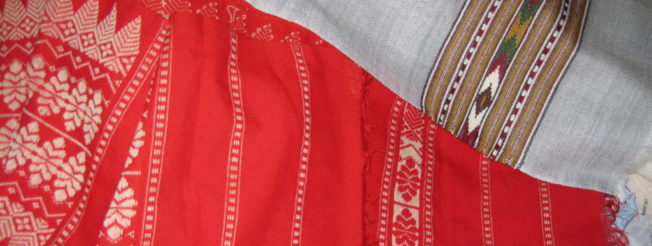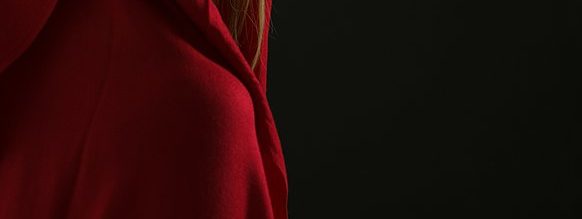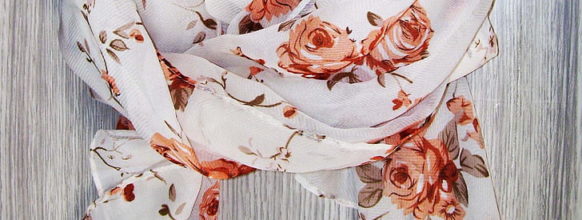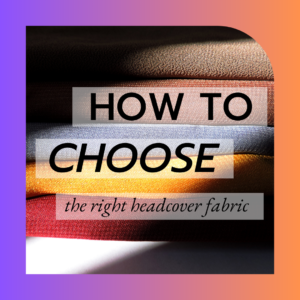
Picking the Right Fabric for Veiling
Headscarves are an integral part of many cultural and religious traditions worldwide. They are made from various fabrics, each offering unique advantages and disadvantages. Understanding the pros and cons of different materials can help you select the most suitable headscarf for comfort, style, and purpose. This article delves into the standard fabrics used for headscarves and their respective qualities.
.

Cotton
Cotton is one of the most widely used fabrics for headscarves due to its natural and breathable properties. Derived from the fibers of the cotton plant, this fabric is known for its versatility and comfort. It allows for excellent air circulation, making it a comfortable choice, especially in hot and humid climates. Additionally, cotton is gentle on the skin, reducing the risk of irritation, and its absorbent nature effectively manages sweat, keeping the wearer cool and dry
Pros
- Breathability: Cotton allows air circulation, making it comfortable to wear, especially in hot climates.
- Softness: It is gentle on the skin, reducing the risk of irritation.
- Absorbent: Effective in absorbing sweat, keeping the wearer cool and dry
Cons
- First and foremost, at the top
- Secondly, another item
- Thirdly, a concise point
- Fourth, a bit more description
Pros
- Softness: Silk feels exceptionally smooth and comfortable against the skin.
- Lightweight: It is light and drapes beautifully, adding an elegant touch.
- Temperature Regulation: Silk has natural temperature-regulating properties, keeping you cool in summer and warm in winter.
Cons
- Cost: Silk is more expensive compared to other fabrics.
- Care: Requires special care, including hand washing or dry cleaning, and is prone to water spots and wrinkles.
- Slippery: Its smooth texture can cause it to slip out of place, requiring frequent adjustment.

Silk
Silk is a luxurious fabric known for its smooth texture and elegant appearance. Produced from the fibers of silkworms, silk has been prized for centuries for its beauty and softness. It feels exceptionally soft and comfortable against the skin, providing a luxurious wearing experience. Additionally, silk is lightweight and drapes beautifully, adding an elegant touch to any outfit. At the same time, its natural temperature-regulating properties make it suitable for all seasons.

Chiffon
Chiffon is a lightweight, sheer fabric often used for dressy headscarves. Made from silk, nylon, or polyester, chiffon is known for its delicate and airy feel. It offers a dainty, elegant look with a slightly transparent quality, making it ideal for formal occasions and layering. Chiffon is very light and airy, providing comfortable wear, especially in warm weather, and can be used for casual and formal occasions, adding a touch of sophistication to any outfit.
Pros
- Appearance: Offers a delicate, elegant look with a slightly transparent quality.
- Lightweight: Very light and airy, providing comfortable wear.
- Versatile: Can be used for both casual and formal occasions.
Cons
- Durability: Chiffon can tear or snag easily.
- Slip: Like silk, it can be slippery and require frequent readjustments.
- Opacity: Being sheer, it may need a lining or layering for complete coverage.
Pros
- Stretch: Offers excellent stretch and flexibility, making it easy to style.
- Comfort: It is soft and comfortable and conforms well to different head shapes..
- Low Maintenance: Does not wrinkle easily and is machine washable.
Cons
- Thickness: Can be thicker and warmer, which might be uncomfortable in hot weather.
- Durability: It may pill or lose shape over time depending on the quality.
- Appearance: Less formal compared to silk or chiffon.

Jersey
Jersey is a stretchy, knit fabric known for its comfort and versatility. The jersey is made from cotton, wool, or synthetic fibers and is widely used for casual and everyday headscarves. It offers excellent stretch and flexibility, making it easy to style and wear. Additionally, the jersey conforms well to different head shapes. It provides a snug fit, while its low-maintenance properties make it a practical choice for daily wear, as it does not wrinkle easily and is machine washable.

Viscose/Rayon
Viscose, or rayon, is a semi-synthetic fiber made from wood pulp, balancing natural and synthetic qualities. It is known for its versatility and ability to mimic the feel of natural fibers like silk and cotton. The viscose feels smooth and soft, providing a comfortable wearing experience. Additionally, it drapes beautifully, offering an elegant look and fluid movement, making it suitable for various styles. Viscose is also generally breathable and comfortable, making it ideal for different weather conditions.
Pros
- Softness: Feels smooth and soft, similar to cotton.
- Drape: Drapes beautifully, providing an elegant look.
- Breathability: Generally breathable and comfortable to wear.
Cons
- Care: Can be delicate, requiring careful washing and handling.
- Wrinkling: Tends to wrinkle easily, needing frequent ironing.
- Durability: Can weaken when wet and may shrink if not correctly cared for.
Pros
- Durability: Highly durable and resistant to wear and tear.
- Low Maintenance: Easy to wash and quick to dry, with minimal wrinkling.
- Cost-Effective: Generally more affordable compared to natural fabrics.
Cons
- Breathability: Less breathable, which can be uncomfortable in hot weather..
- Feel: Can feel less soft and more synthetic against the skin.
- Static: Prone to static cling, especially in dry conditions.

Polyester
Polyester is a synthetic fabric known for its durability and ease of care. Made from petroleum-based products, polyester is widely used in fashion for its resilience and versatility. Polyester is highly durable and resistant to wear and tear, making it a long-lasting fabric choice. Additionally, it is easy to wash and quick to dry, requiring minimal care and not wrinkling easily, making it a practical option for those seeking low-maintenance fabrics. Polyester is generally more affordable than natural fabrics, making it a budget-friendly option.

Bamboo
Bamboo fabric is a sustainable option known for its softness and eco-friendliness. Derived from the fibers of the bamboo plant, this fabric is becoming increasingly popular for its environmental benefits and luxurious feel. Bamboo fabric feels incredibly soft and smooth, comparable to silk, providing a comfortable and gentle wearing experience. Additionally, it is naturally antibacterial and hypoallergenic, making it suitable for sensitive skin. Bamboo is also highly breathable and moisture-wicking, keeping the wearer cool and dry.
Pros
- Eco-Friendly: Bamboo is a renewable resource, and its cultivation has a lower environmental impact.
- Softness: Feels incredibly soft and smooth, comparable to silk.
- Antibacterial: Naturally antibacterial and hypoallergenic, making it suitable for sensitive skin.
- Breathable: Highly breathable and moisture-wicking, keeping the wearer cool and dry.
Cons
- Cost: Generally more expensive than cotton or polyester.
- Care: Requires gentle washing to maintain its properties.
- Durability: It can be less durable than synthetic fabrics, especially if not adequately cared for.
Pros
- Breathability: Extremely breathable and comfortable, especially in hot weather.
- Durability: Strong and long-lasting, becoming softer with each wash.
- Eco-Friendly: Flax cultivation has a lower environmental impact than cotton.
Cons
- Wrinkling: Prone to wrinkling, requiring frequent ironing for a neat appearance.
- Texture: Can be rough initially but softens over time.
- Cost: Typically more expensive than cotton due to its labor-intensive production process.

Linen
Linen is a natural fabric made from flax fibers, known for its strength and coolness. It has been used for thousands of years and is prized for its breathability and durability. Linen is exceptionally breathable and comfortable, making it an excellent choice for hot weather as it allows air to flow freely, keeping the wearer cool. Additionally, linen is strong and long-lasting, becoming softer with each wash. Linen is also eco-friendly, as flax cultivation has a lower environmental impact than cotton.

“Understanding each fabric’s pros and cons can help make an informed decision that best suits one’s needs and lifestyle..”
Conclusion
Choosing the suitable fabric for a headscarf depends on personal preferences, the intended use, and the climate. Cotton and jersey are excellent choices for everyday wear due to their comfort and breathability. At the same time, silk and chiffon are ideal for formal occasions due to their elegant appearance. Viscose offers natural and synthetic benefits, while polyester provides durability and ease of care. Bamboo stands out for its eco-friendliness and softness, and linen is perfect for hot climates with its excellent breathability. Understanding each fabric’s pros and cons can help make an informed decision that best suits one’s needs and lifestyle.

0 Comments